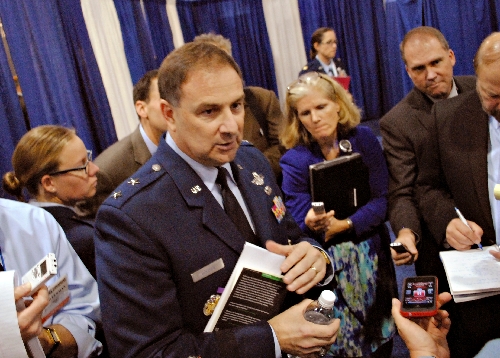Despite concerns, general confident in new F-35 fighter

NATIONAL HARBOR, MD. – The deputy director of the F-35 Joint Strike Fighter program said Monday that he has “reasonable confidence” in the combat jet but still has concerns about hardware and software.
Speaking publicly for the first time about the program he joined five weeks ago, Maj. Gen. Christopher C. Bogdan said contractor Lockheed Martin Corp. is making progress in producing the aircraft, but more rigorous testing is needed to see whether it is combat-ready.
“The gorilla in the room is software,” Bogdan said at the Air Force Association’s annual Air & Space Conference.
Three dozen F-35s are expected to call Nellis Air Force Base home. The first four planes are due early next year at the fighter pilot training range. The U.S. military plans to buy 2,443 Joint Strike Fighters by 2037 as aging F-16s, A-10s and F-18s are retired.
More than a dozen F-35s are being used for flight tests and pilot training at Edwards Air Force Base, Calif.; Eglin Air Force Base, Fla.; and Naval Air Station Patuxent River, Md.
“We’re learning a lot about the airplane,” Bogdan said.
The Air Force is about a third of the way through flight tests but has yet to put the aircraft through more complex maneuvers and missions. Still, testing is ahead of schedule, he said.
Bogdan said the program has fallen about three to four months behind in developing the 10 million lines of software code for the aircraft to perform as advertised. And he said there are ongoing problems with the cutting-edge pilot helmet that is critical to flying the plane.
“Today we have a helmet that works in a very rudimentary way,” he said.
The carbon-fiber helmet, rigged with night-vision cameras, is designed to give pilots a 360-degree view of their surroundings. Early testing has found that the pictures and symbology transferred to the visor suffer from split-second delays, jitters and other problems for pilots flying beyond the speed of sound.
Bogdan said he does not expect that Vision Systems International, a Lockheed Martin subcontractor, will be able to resolve all of the issues with the helmet by 2015, when the Marine Corps hopes to start using the aircraft in combat.
“Some things we can fix fairly quickly by 2015. Some things just are not going to happen because they are hardware-related,” he said.
Bogdan said he was confident of having a workable helmet in the long term, but more testing is needed to see whether pilots can get by with the helmet available today. The Pentagon has dedicated one of its F-35 test planes in Maryland to explore that question.
“Over the next 60 to 90 days we are going to gather as much information about the helmet as we can,” Bogdan said.
Project managers will evaluate a backup helmet being developed by BAE Systems over the next 120 days, he said.
Contact Stephens Washington Bureau reporter Peter Urban at purban@stephensmedia.com or at 202-783-1760.